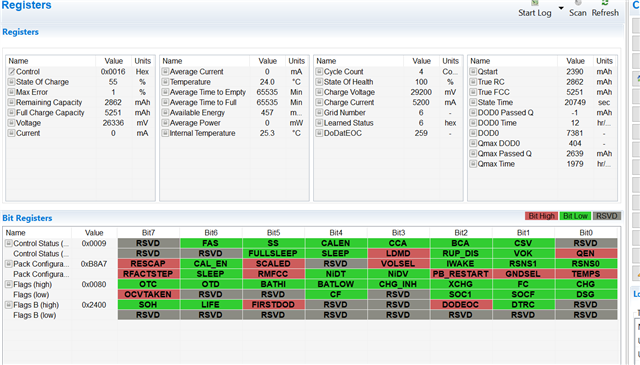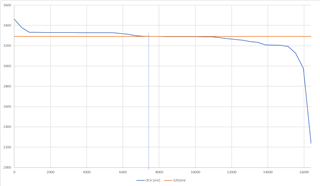Tool/software:
three Tierra Rejada cycles 1 hour rest June 19 2025.logGotion Relaxation Log Post VCal.log
I am trying to understand why the gauge would make a remaining capacity adjustment while in the flat region and relaxed. I am working with chemID x4201, a 104AH LiFePO4 cell, and a golden image I had successfully acquired using said chem ID. My pack configuration is 16 series 1 parallel, and the shunt size is 50 micro-ohms with a design energy scale of 20. I began with my battery nearly fully charged at 99% SOC and ran three successive dynamic discharge cycles (each cycle is a net ~21 AH discharge, although each cycle contains some short regenerative charge currents). I only allowed on hour between each cycle and therefore never allowed the battery to relax. After 3 the third cycle and before relaxation, the gauge registered 41% SOC, which was satisfactorily accurate within 3% points of expected SOC. After a relaxation period, the gauge increased the SOC by 1% to 42%. I would like to understand why this adjustment is made. The battery is still in the flat region and no QMax update has been made since the start of the three discharge cycles. The VOK bit remains set, the OCVTAKEN bit remains clear, and the FIRSTDOD bit are set, which indicate to me the battery has entered relax mode but no qualified open circuit voltage for a QMax update has occurred. If no QMax update occurs, how can the remaining capacity be adjusted upwards slightly which triggers a 1% increase in SOC? Attached is the log file of each of the three successive dynamic discharge cycles and then a subsequent relaxation log which captures the 41 to 42% SOC adjustment
Please note as well that in between the three discharge cycles and relaxation log, and the relaxation only log, I noticed the gauge voltage reading was slightly off by 80ish millivolts and I re-calibrated it. This is why the voltage suddenly seems to increase



